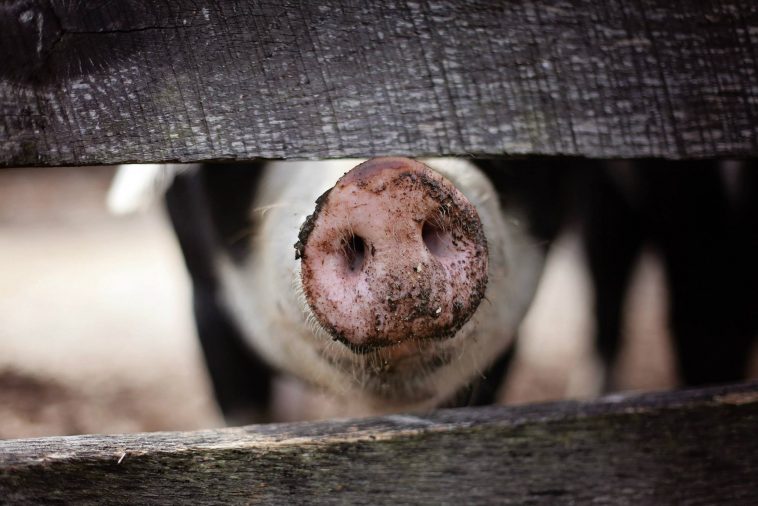Piggery production systems are kept at peak performance by the upholding of a variety of parameters. One of these is health management. Efficient and effective health management safeguards good reproductive performance, consistent pig numbers at all stages of production, and consistent growth factors, which then contribute to a steady, high income for the piggery enterprise.
One of the first steps towards creating a health management system is the use of production records. Various records are utilised to assess performance and identify areas of concern. Record-keeping ensures an efficient diagnosis assessment of the functionality of the treatment and/or mitigation strategies.
The assessment process involves:
- taking an appropriate history of symptoms and collecting relevant data;
- physical examination;
- generating a provisional and differential diagnosis;
- testing, if required (ordering, reviewing, and acting on test results); and
- reaching a final diagnosis and prognosis.
Health records help set targets and motivate farm staff to achieve the targets. Types of records kept are:
- veterinarian records;
- medication and treatment records;
- vaccinations;
- medicated feed mixing records;
- biosecurity checklists;
- visitor logs; and
- needle and drug storage inventories.
An element of health management that springs up right from the inception of the project is biosecurity. Biosecurity encompasses the procedures or measures designed to protect the pigs against harmful biological or biochemical substances.

One of the first steps towards creating a health management system is the use of production records that keep track of your pigs’ health. (Source: pexels.com)
The management of health issues regarding biosecurity can be classified into three fields:
First, there are strategies designed to live with endemic diseases. Generally, endemic diseases are instigated by pathogens that survive in the environment and are too difficult to eliminate, or they are ubiquitous organisms that generally cause few problems. Endemic diseases can be mitigated by maximizing immunity and minimizing the challenge, whereas ubiquitous organisms may be managed by solving environmental- management deficiencies which usually cause them.
The second field is the elimination of pathogens. Their elimination usually involves the administering of chemical substances such as antibiotics, or quarantine to create herd immunity.
The third and last part of biosecurity are actions to prevent pathogens from entering the herd, such as foot baths, spraying of vehicles, and limitation of human movement in the sties.
Poor health management can lead to a population of pigs with underdeveloped immune systems, stress leading to a weakened immune system, overwhelming pathogen challenges, or the entry of new pathogens into a population of pigs without specific immunity.
Health conditions affecting pigs include parasitic diseases, which may be internal or external. Parasitic diseases are roundworm and tapeworm that can be controlled with medicine in the food, and the provision of clean and dry pens, periodic disinfection of sties, separation of young ones from adults, washing sows before farrowing, and preventing the pigs from wandering about where they can feed on human faeces.

External parasites such as mange, lice, myiasis can be solved by scrubbing sows with Gamma BHC insecticides four days before farrowing, cleaning and scrubbing the farrowing pens before use, maintaining proper animal nutrition and health programmes to reduce severity and spread. Recommended control products for this are: Ivermectin (1% injectable), or Malathion (1% spray).
Reproductive disorders and diseases include anaphrodisia, leptospirosis, brucellosis, uterus prolapse, mastitis and endometritis (bacteria). Preventative measures include improved feeding of mineral-rich feeds, regular deworming, vaccination, and hygienic measures.
Diseases and disorders of the digestive tract are scouring, birth diarrhoea, red diarrhoea or clostridial enteritis, transmissible gastroenteritis, salmonellosis, and swine dysentery. Measures to mitigate this include but are not limited to keeping pens, feed, and watering troughs clean, separation of affected animals from healthy animals, and keeping the pigs warm.
Some of the diseases of the respiratory are influenza, pseudorabies, pneumonia, atrophic rhinitis and pasteurellosis. Preventative measures are good ventilation, vaccination, hygiene, and the use of antibiotics.
Under nutritional disorders is anaemia which can be treated by providing iron injections or oral iron-paste containing iron, feeding compost of good quality and supplied daily, as compost of poor quality may contain bacteria, and wood ash can also be put into the pen.
Other diseases are foot and mouth disease (FMD), swine fever/hog cholera and anthrax. Mitigation includes vaccination, quarantine, use of antibiotics and sometimes thorough disinfection of the farm and burning of carcasses.

(Source: pexels.com)
The existence of a health anomaly for a pig may present itself by:
- the pig not eating or not showing an interest in feed and or water;
- rapid breathing which is usually indicative of a fever;
- white pigs may become reddish;
- diarrhoea which may be bloody or blood-stained;
- droopy ears or ears pointing downwards;
- dull eyes;
- dull skin and hair;
- a limp tail;
- and the pig may separate itself from the herd.
Generally, as elaborated, it is paramount for farmers to constantly monitor and assess the state (behavioural and physical) of their herd for the early detection of any health issues.








